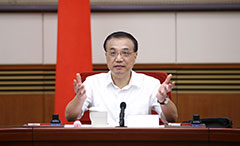Revised tax rules show progress in VAT reform
2017-11-07
China Daily
The State Council, China’s Cabinet, has approved a revised regulation that marks a milestone in China’s reform to replace corporate tax with value-added tax.
Since the 1950s, the country has taxed companies based on their revenue.
Yet after VAT was introduced on goods in 2008, businesses began to complain that the levy on services was a kind of double tax.
To ease the burden, the central government launched a reform in 2012 aimed at phasing out corporate tax and introducing VAT at each stage of the production chain. The pilot was gradually expanded, and the collection of corporate tax was scrapped in May last year.
On Oct 30, a State Council executive meeting which was presided over by Premier Li Keqiang approved a draft amendment to the tax regulation, to clarify the policy. The rule-change is expected to soon be followed by legislation.
“The decision to scrap corporate tax means China’s VAT reform has been a success, with all sectors having adjusted to the new system,” Liu Jianwen, a professor at Peking University Law School and specialist on tax regulation.
He added that he expects the revised regulation to fine-tune the transitional policies for certain industries.
The VAT reform was first piloted in Shanghai, starting on Jan 1, 2012, and focused only on transportation and modern services. Later that year, it was expanded to eight provincial regions, including Beijing and Jiangsu province.
The system was rolled out nationwide in August 2013, with TV and broadcasting added to the list of sectors.
Railways and telecommunications were incorporated in January 2014, and on May 1 last year, VAT was introduced to the last four sectors: construction, real estate, finance, and consumer services.
By the end of September, the reform had saved companies more than 1.6 trillion yuan ($240.9 billion) in tax, according to data from the Ministry of Finance. This includes a reduction of at least 850 billion yuan in the 12 months up to June.
Liu said introducing VAT has been the government’s most important action in cutting taxes and lowering the burden on enterprises.
“One highlight of the reform is that it will help China nurture new economic drivers in the long run, lowering the pressure on tertiary industry, which will help the economy grow in a healthier and sustainable way,” he said.
However, he added that the State Council will need more time to evaluate how VAT affects all sectors before the final revised regulation is released.
“Over the past 18 months, the Ministry of Finance and the State Administration of Taxation have issued a slew of regulations to complement the VAT reform, so that companies have something to refer to when paying their taxes,” Liu said.
Zhang Bin, a researcher at the Chinese Academy of Social Sciences’ National Academy of Economic Strategy, said, “Further efforts are required to make the VAT system more comprehensive and improve the fiscal distribution relationship between central and local governments.”
The decision to approve the new rules last week followed a meeting chaired by the premier in September in which he stressed that the nation’s tax policies must be fine-tuned.
“The process should be streamlined for taxpayers with the use of information technology. There should also be a crackdown on illegal activity, such as tax evasion,” Li said, as he called for more research on a standard VAT rate.
China’s tax rate structure was reduced from four tiers to three in July — now simply 6 percent, 11 percent and 17 percent — while the levy on farm produce, tap water and books was reduced from 13 percent to 11 percent.
On Oct 30, it was announced that duties on the sale of imported goods such as grains and animal feed would also be lowered from 13 percent to 11 percent, while transitional policies for other sectors remained unchanged.


